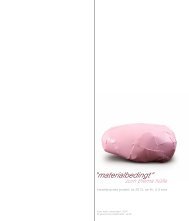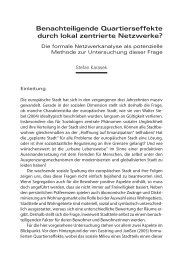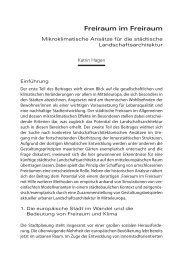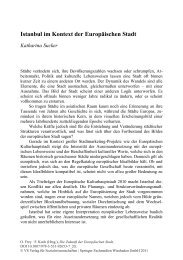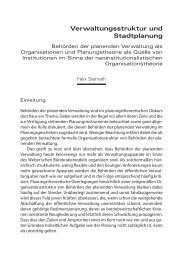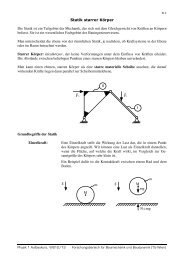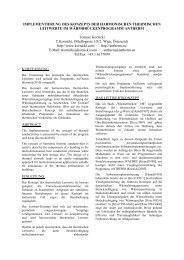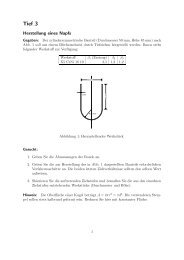translated by Chris Clouter The Regime of - TU Wien
translated by Chris Clouter The Regime of - TU Wien
translated by Chris Clouter The Regime of - TU Wien
Create successful ePaper yourself
Turn your PDF publications into a flip-book with our unique Google optimized e-Paper software.
Published in: Josef Trattner (Hg.): Foam. Vienna: Edition Selene, 2004, pp. 255-261;<br />
<strong>translated</strong> <strong>by</strong> <strong>Chris</strong> <strong>Clouter</strong><br />
<strong>The</strong> <strong>Regime</strong> <strong>of</strong> Heteronomous Cultural Agents<br />
Anita Aigner<br />
“<strong>The</strong> heteronomous producer, whom the Italians magnificently call<br />
tuttologo, is the Trojan horse <strong>by</strong> means <strong>of</strong> which all forms <strong>of</strong> social<br />
stranglehold – that <strong>of</strong> the market, <strong>of</strong> fashion, <strong>of</strong> the state, <strong>of</strong> politics, <strong>of</strong><br />
journalism – are imported into the field <strong>of</strong> cultural production.”<br />
(Pierre Bourdieu)<br />
Autonomy in the different fields <strong>of</strong> cultural production, hard won over the course <strong>of</strong> history, is<br />
not a commodity which will last for eternity. On the contrary, it has to be continually nurtured<br />
and defended <strong>by</strong> incessant work against ever new forms <strong>of</strong> threat. All the more so as the<br />
threats burdening the spheres <strong>of</strong> artistic production today are cunning in approach and remain<br />
invisible.<br />
What is happening to artistic production in modern industrial societies today is<br />
something which has never happened before: the new forms <strong>of</strong> influence do not take effect<br />
through personal relationships (such as between a painter and his client) or through political<br />
power (for example, the persecution and appropriation <strong>of</strong> art during the dictatorial regimes <strong>of</strong><br />
the 20th century), but instead adopt the form <strong>of</strong> a power which is difficult to grasp, enforces<br />
itself through very general mechanisms and evolves in confederacy with the media – i.e. that<br />
<strong>of</strong> the market. Even the microcosm <strong>of</strong> autonomous production or the avant-garde, if you will,<br />
which has always formed itself <strong>by</strong> a rejection <strong>of</strong> the market, has not stood in opposition to the<br />
market for a long time. Artistic products as much as the names <strong>of</strong> the producers are employed<br />
as carriers for advertising everywhere: whether it be cities, political parties, banks or<br />
international fashion houses, they all increasingly compete in the fight to get noticed with the<br />
help <strong>of</strong> sensational artistic production and big names. ‘Culture’ and famous names have<br />
become an economic resource and marketing factor.<br />
Admittedly, the influence <strong>of</strong> commercial forces on cultural or artistic fields, the market<br />
situation as such, is nothing new. However, the dividing line between artistic experiment and<br />
event culture has never been as blurred as it is today, nor have the economic and social<br />
conditions for cultural production ever been permeated so much <strong>by</strong> the logic <strong>of</strong> pr<strong>of</strong>it, and the<br />
success <strong>of</strong> art defined so much <strong>by</strong> visitor numbers and viewing statistics, <strong>by</strong> their reception in<br />
1
the press and on television. Servility towards the press – an unmistakable sign <strong>of</strong><br />
heteronomous cultural production – also increasingly takes hold <strong>of</strong> the autonomous producers<br />
<strong>of</strong> culture (who are to be understood as those defining the form and content <strong>of</strong> their work<br />
themselves) when they endure the power <strong>of</strong> mass media having its effect from without and<br />
even readily accept and adopt the logic <strong>of</strong> marketing as their own. However, it is the influence<br />
<strong>of</strong> people in the media first and foremost which is penetrating deeper into these autonomous<br />
factions than ever before. What can be seen to be happening, among other things, is that<br />
leading positions in the art and culture industry are being taken over <strong>by</strong> media executives. <strong>The</strong><br />
negative effect for cultural producers is that those who have the means <strong>of</strong> mass circulation at<br />
their disposal also now have the power to sanction.<br />
Contrary to the promises <strong>of</strong> demagogues who confer democratic legitimacy on the<br />
media <strong>by</strong> insisting on granting everybody ‘the right to culture’, the supremacy <strong>of</strong> the media<br />
represents one <strong>of</strong> the greatest threats to cultural production, as Pierre Bourdieu has repeatedly<br />
stressed.1 Media supremacy does not just result in the breakdown <strong>of</strong> the principle <strong>of</strong> internal<br />
hierarchy inside the field <strong>of</strong> cultural production through criteria <strong>of</strong> evaluation external to it,<br />
and the increasing involvement <strong>of</strong> people (i.e. in art production, discourse or selection) who<br />
are not completely conversant in the specific values <strong>of</strong> the artistic field. <strong>The</strong> main<br />
consequence is that a superficial knowingness and a need to be part <strong>of</strong> it all is sweeping over<br />
any serious debate or expert preoccupation with the issues, and the forms <strong>of</strong> mediation have<br />
nothing other than a certain type <strong>of</strong> publicity at their disposal.<br />
So what can be done to prevent artists from completely losing the right <strong>of</strong> disposal<br />
over their means <strong>of</strong> production and distribution? An attempt to rescue the “autonomous<br />
artwork” as it was once instigated <strong>by</strong> Adorno seems hopelessly passé in the face <strong>of</strong> a culture<br />
industry which is also getting increasingly better at making self-referential, autonomous<br />
production into a marketing factor for cities and tourism in international competition.<br />
Nonetheless, it would be expedient to analyse the effects <strong>of</strong> the criteria introduced from<br />
outside the field and championed in the main <strong>by</strong> media people in various areas <strong>of</strong> art. True to<br />
the old adage that one can only have an effect on the world if one knows something <strong>of</strong> it,<br />
artists can first defend themselves against the unreasonable demands <strong>of</strong> an art industry<br />
controlled <strong>by</strong> media producers when they recognise the determining factors they are subject<br />
to.<br />
2
In view <strong>of</strong> the virtuosity with which many artists operate the keyboard <strong>of</strong> the media, one could<br />
at any rate be seized <strong>by</strong> strong misgivings as to whether an independence from external<br />
powers (e.g. the media) represents a basic value in the field <strong>of</strong> art. Although artists<br />
increasingly tend towards collaboration with the media, i.e. towards an unconditional<br />
subordination to constraints which undermine the norms <strong>of</strong> an artistic field, they have only<br />
been able to defend themselves occasionally against impertinences in the exploitation <strong>of</strong> their<br />
activities <strong>by</strong> the mass media with great difficulty. This happens primarily in the broader media<br />
where uninformed journalistic commentaries appear and mar the meaning and value already<br />
ascribed to artistic contributions from inside the field and, as can be seen in Josef Trattner’s<br />
contribution to the cultural capital Graz 2003 project, in populist picture production as well,<br />
which transforms an experimental event into a trivial effort within a spectacle.<br />
As annoying as the sensation-hungry versions <strong>of</strong> artefacts and cultural events in the<br />
mass media may sometimes be, one has to give due cognisance to these forms <strong>of</strong> ‘reception’,<br />
even though they are considered as inexpert and therefore inferior from the standpoint <strong>of</strong><br />
competent critics and informed recipients. <strong>The</strong> problem is not so much that the local and<br />
tabloid press report on the art event in a superficial manner but more that a relational logic has<br />
established itself between the political protagonists, the cultural managers and media people,<br />
making it axiomatic to collaborate with the ‘broadest’ media. It has become unthinkable to act<br />
outside the media.<br />
It comes as no surprise then that cultural politicians themselves, who naturally have a<br />
vested interest in obtaining recognition for their activities via the media, call precisely those<br />
people to the conductor’s podium who have the means at their disposal to broadcast cultural<br />
products to all and sundry. This not only results in the compilation <strong>of</strong> programmes following<br />
heteronomous criteria but also to cultural products being mediated in a form tailored to media<br />
requirements. As a cultural event is only considered to be a success today – at least as far as<br />
the heteronomous criteria <strong>of</strong> journalists and media producers are concerned – when it has<br />
been well received <strong>by</strong> the press and television, which usually lack crucial expert awareness,<br />
the products are immediately adapted – naturally with the assistance <strong>of</strong> PR advisers and<br />
marketing specialists – with a view to circulation through the widest media coverage. All the<br />
more so, <strong>of</strong> course, when those in charge actually come from the media themselves. Now one<br />
could think that not much could go wrong precisely as far as the pictorial mediation <strong>of</strong> art<br />
events is concerned because pictures simply just ‘record’. However, contrary to the<br />
presumption that pictures (more than texts) describe indisputable reality, they are (like texts)<br />
the product <strong>of</strong> a relatively explicit process <strong>of</strong> selection and construction. <strong>The</strong> fact that the<br />
3
‘perception filter’ <strong>of</strong> people in the media produce social representations which do not tally<br />
with the perception criteria inside the field <strong>of</strong> art and create a reality for the medial viewing<br />
attitudes <strong>of</strong> decision makers which eventually damage art, can also be seen in connection with<br />
Josef Trattner’s Graz 2003 project.<br />
It is <strong>by</strong> no means unimportant that advance recognition was given to the intervention in which<br />
Trattner positioned a total <strong>of</strong> 42 foam rubber blocks at 11 public sites in the old centre <strong>of</strong> Graz<br />
on 31st March, 2003. It already possessed significance and a special status <strong>by</strong> being<br />
proclaimed the highpoint in the genre ‘art in public spaces’ <strong>of</strong> the Graz cultural capital<br />
programme. <strong>The</strong> project was legitimised as ‘art’ beforehand, which should <strong>by</strong> no means be<br />
taken for granted, and as such it utterly corresponded with the expectations and selection<br />
criteria <strong>of</strong> journalists and media photographers, who are always in search <strong>of</strong> something<br />
sensational and spectacular. Put on the scent <strong>by</strong> the cultural capital’s press releases and preinformed<br />
in the actual sense <strong>of</strong> the word <strong>by</strong> ‘medially conditioned’ press texts, they were<br />
attracted to an event laden with headline potential – it was after all a story which could make<br />
the front page <strong>of</strong> the local newspapers. This was later confirmed in the Steirerkrone <strong>of</strong> 1st<br />
April, 2003. (ill. 1)<br />
<strong>The</strong> leading article picture shows a pretty young woman sitting on a pink foam rubber<br />
block, who is holding the cultural capital Graz 2003 logo up high and is visibly delighted at<br />
being an ornament like in the car advertisement. <strong>The</strong> influence exerted <strong>by</strong> the directing body<br />
<strong>of</strong> the cultural capital on the media ‘exploitation’ <strong>of</strong> the art project, the working collaboration<br />
between those responsible for the cultural capital and the media, is evident in this, even<br />
though the result would only have been perfect in the eyes <strong>of</strong> marketing people if the artist<br />
had let himself be photographed with the logo – something noteven an old member <strong>of</strong> the<br />
avant-garde such as Vito Acconci stops short at.<br />
That the responsible culture ‘makers’ share the same categorisations for thought,<br />
action and perception as media people (something which naturally becomes most apparent<br />
when the media ‘makers’ are likewise ‘makers’ <strong>of</strong> large cultural events), can best be<br />
illustrated <strong>by</strong> the fact that a picture similar to that in the Steirerkrone was to be found in the<br />
programme book <strong>of</strong> Graz 2003. (ill. 2)<br />
It should be mentioned in passing that this photograph was taken <strong>by</strong> a different<br />
photographer. Nevertheless, this only goes to confirm that the media photographers who were<br />
present on location on the first day picked up on the arrangements made <strong>by</strong> PR pr<strong>of</strong>essionals<br />
‘completely naturally’, to some extent taking up the ball that had been played them. This was<br />
4
how the organisers controlled the media exploitation <strong>of</strong> the intervention without anyone<br />
becoming conscious <strong>of</strong> the fact. Simply <strong>by</strong> understanding how to address the journalists and<br />
photographers so that they did exactly what was expected <strong>of</strong> them.<br />
Of course a cultural product is never bad just because it appears on television or is all over the<br />
newspapers. <strong>The</strong>n again it is also never good simply for the same reasons. Moreover, it<br />
certainly does not get adequate representation automatically through media depictions, and<br />
this is the core <strong>of</strong> the problem. Exactly the opposite is true in fact as the images produced in<br />
the name <strong>of</strong> culture industry marketing paradoxically conceal what they are putting on show.<br />
A slightly more obvious effect <strong>of</strong> media exploitation is to be found in the fact that a<br />
situation created <strong>by</strong> an artist to be experienced was shown in a way which was inappropriate<br />
to it, no matter how well intended it might have been. <strong>The</strong> event took on a meaning which had<br />
very little or nothing to do with reality, or the meaning or possible meaning created inside the<br />
universe <strong>of</strong> art. At any rate, the images and texts produced in accordance with the perception<br />
and evaluation criteria <strong>of</strong> media and marketing experts portrayed the artistic contribution in a<br />
very definite way. <strong>The</strong>y did not show it as they should have. It could also be said that they did<br />
not represent the art event but falsified it instead, even contributed to its demise<br />
unintentionally with their specific representation.<br />
For the images and texts to actually have done what they pretended to, namely inform,<br />
they would have had to provide not just a suggestion <strong>of</strong> the whole project – only a single<br />
object was shown from an installation consisting <strong>of</strong> 432 – but they would also have had to<br />
convey some idea <strong>of</strong> the processes <strong>of</strong> change anticipated for these objects which had been<br />
made available for general use and manipulation. It was after all planned that the blocks<br />
would be exposed to transformations through the weather and public for a bit longer than half<br />
a year. However, journalists only have eyes for what they are capable <strong>of</strong> seeing. <strong>The</strong>y see the<br />
here and now <strong>of</strong> the immediate, the obvious fact <strong>of</strong> ‘fun and colourful objects’ populating<br />
public space. <strong>The</strong>y needed a ‘sensation’ and felt obliged to show that something was<br />
‘missing’ in the cultural capital and not to explain a situation to be experienced created <strong>by</strong> an<br />
artist. As a result they were also incapable <strong>of</strong> taking on the accidental, the uncontrollable and<br />
unpredictable, which was an essential dimension <strong>of</strong> the intervention.<br />
However, the journalists cannot be made personally responsible for their reductive and<br />
flippant depictions as they are themselves subject to the rules and practices <strong>of</strong> journalism<br />
as well as a whole range <strong>of</strong> other constraints: they are under time pressure, are obliged to use<br />
a medial turn <strong>of</strong> phrase, and are subject to the constraint <strong>of</strong> having to describe a thing in such<br />
5
a way as to make it into a headline story – the dramatisation effect. Unfortunately, the lack<br />
<strong>of</strong> specialist knowledge along with the prescribed shortness <strong>of</strong> a report <strong>of</strong>ten do not permit a<br />
pertinent discussion <strong>of</strong> an issue as well.<br />
Now one could argue that the distorting effect <strong>of</strong> the media is being exaggerated here. After<br />
all, a form <strong>of</strong> use was insinuated with the woman posing on the foam rubber block – at least<br />
as far as the allegation that the aspects <strong>of</strong> appropriation and transformation <strong>of</strong> the objects are<br />
thematicised beforehand is concerned. Moreover, the short text in the Graz 2003 programme<br />
book did announce that the foam rubber blocks were an invitation “to occupy them, to settle<br />
down on them, to arrange them, to use them”, even “to wear them out.” To counterbalance<br />
this, however, it must be stressed that the wide-impact reports carrying this pictorial motif<br />
were generated out <strong>of</strong> the logic <strong>of</strong> event announcement. As such, these contributions <strong>by</strong> the<br />
mass media mainly fulfilled the function <strong>of</strong> advertising for the Graz 2003 cultural event.<br />
Neither the Graz 2003 project organisers nor the journalists were concerned with attributing<br />
the art intervention with any specific meaning or value here. <strong>The</strong> project’s ‘lustrous side’<br />
seemed to be <strong>of</strong> much more importance, i.e. the superficial effect <strong>of</strong> “aesthetic punctuation in<br />
public space” (as the Graz 2003 homepage formulated it) and the criterion <strong>of</strong> public<br />
effectiveness (and so the potential for media exploitation implicitly as well), which must have<br />
motivated the organisers to include it in the programme. Accordingly, these images and press<br />
reports sufficed in their task <strong>of</strong> suggesting a treatment <strong>of</strong> art which was as uncomplicated as<br />
possible and a broad acceptance for these fun and colourful objects. Where<strong>by</strong> the innocuous,<br />
cheerfully nice and clean art reality produced <strong>by</strong> the media was also the desired product <strong>of</strong> the<br />
responsible culture maker as well.<br />
It is necessary to constantly remember that the media does not merely report on reality<br />
alone but that it ‘creates’ one. As Patrick Champagne stresses in his study <strong>of</strong> the publicity<br />
treatment <strong>of</strong> the misery in the outskirts <strong>of</strong> large French cities, “the media produce reality<br />
effects <strong>by</strong> creating a media oriented way <strong>of</strong> seeing things, which contributes to the creation <strong>of</strong><br />
a reality which it pretends to describe.”3 <strong>The</strong> medially conditioned discussion <strong>of</strong> art also<br />
produces spontaneous social representations which only express intentions or issues <strong>of</strong> the<br />
cultural producers in a limited way. In the case <strong>of</strong> Trattner’s intervention, a ‘clean’ object was<br />
constructed which utterly contrasted with the planned and completely public process <strong>of</strong><br />
‘deterioration’ in the object, its deformation, soiling and development right through to<br />
‘shapeless’ material. <strong>The</strong> media perspective here created an object which clashed with<br />
the ‘actual’ object. It created an image <strong>of</strong> the art project which would eventually lead to the<br />
projects interruption and termination.<br />
6
<strong>The</strong> termination <strong>of</strong> the intervention was essentially due to the fact that the organisers<br />
<strong>of</strong> the cultural capital did not share the artist’s view but that <strong>of</strong> the media instead. In addition,<br />
art projects in public spaces stand under the auspices <strong>of</strong> the media more than those taking<br />
place in protected spaces. <strong>The</strong> medial artefact <strong>of</strong> “public opinion”4 hung like the sword <strong>of</strong><br />
Damocles over the intervention. <strong>The</strong> fact that this so-called public opinion threatened to<br />
change in the face <strong>of</strong> the soiled, the disorderly and the abject (which had been shoved into the<br />
background beforehand even though it had been reckoned with), clearly explains the<br />
organisers’ change in attitude as well (as far as one can talk <strong>of</strong> their having an attitude at all);<br />
more concretely, the attitude <strong>of</strong> the director which led to the premature removal <strong>of</strong> the foam<br />
rubber blocks from the city, which had become “unsightly”. However, behind the banal<br />
criticism which was intended to justify the termination – the objects no longer appealed on an<br />
aesthetic level, they even represented a danger to public safety – hid anonymous and invisible<br />
mechanisms based on a recognition <strong>of</strong> the power <strong>of</strong> the media.<br />
In order to understand why such a power can develop, reference must first be made to<br />
the fact that, although the ideological constitution <strong>of</strong> those who decide on culture tolerates art<br />
as a ‘hard locational factor’, this does not hold true for art as a medium with which questions<br />
on the condition <strong>of</strong> public spaces are raised. Some business people did protest against the<br />
‘mess’ in front <strong>of</strong> their shop doors – which only goes to show that public space is not so<br />
public after all – but the art intervention only became a problem for the cultural capital<br />
organisers when the press began to report negatively.<br />
<strong>The</strong> symbolic power <strong>of</strong> the media, which not only has an effect on those who are on<br />
the receiving end but also those who exercise it, is founded upon the fact that the media<br />
succeeds in getting whatever it reports on to be taken for the truth. In any event, the director’s<br />
decision to prematurely remove the <strong>by</strong> then “unsightly” foam rubber blocks from the city<br />
centre was a product <strong>of</strong> mass media logic. It was a form <strong>of</strong> submission to the dominance <strong>of</strong><br />
the media in as far as it was not, as it was being presented to the outside world, a reaction to<br />
an unexpected transformation – the experimental situation had been announced as such – but<br />
was instead a reaction to negative press coverage. <strong>The</strong> local press had proclaimed the project,<br />
which it had naïvely seen as solely about ‘furnishing up’ the city with colourful objects, as the<br />
“flop <strong>of</strong> the week”: “<strong>The</strong> ‘good pieces’ were so desolate after just a few weeks that they now<br />
have to be removed again.” Now it is debatable whether the vulgar, individual meanness<br />
which is at the root <strong>of</strong> the media verdict on the experimental situation was shared <strong>by</strong> the<br />
cultural organisers. A number <strong>of</strong> things would speak for this homology; in any case, the<br />
trigger for withdrawal was a fear <strong>of</strong> losing control over the public opinion produced <strong>by</strong> the<br />
7
media and the circumstance that the ‘popularity’ or ‘social success’ <strong>of</strong> the project, i.e. its<br />
recognition <strong>by</strong> a wide public and therefore also the reputation <strong>of</strong> Graz as the cultural capital,<br />
were at stake.<br />
<strong>The</strong> real damage done <strong>by</strong> the medial view <strong>of</strong> cultural production lies in the fact that the art<br />
intervention was robbed <strong>of</strong> its critical dimension, something it adopts in opposition to the<br />
culture industry and the legitimate (predominant) patterns <strong>of</strong> perception held towards art. <strong>The</strong><br />
artist publicly refused to produce artefacts that could be marketed as articles, left the classical<br />
term ‘autonomous artwork’ for such work behind him, and delegated the task <strong>of</strong> creating form<br />
to the public, an act which is reserved for an artist in the orthodox tradition. What then is<br />
more central to the situation the artist created here than a form <strong>of</strong> self-questioning which<br />
investigates the circumstances and conditioning dictating how art is viewed, the tacit<br />
acceptance <strong>of</strong> a supertemporal principle, and the recognition <strong>of</strong> the artwork as such? Does the<br />
ephemeral staging <strong>of</strong> this transient ‘art <strong>of</strong> decay’, which dissolves within a short time into<br />
nothingness (albeit prematurely here) and is apparently messy but nevertheless tears the body<br />
with it, not also provoke the question <strong>of</strong> what art can and should do in public consumer<br />
zones? Does it not demonstrate how damaged consumer society and the public space<br />
consumerism has entirely absorbed actually is?<br />
Is the public not called upon to examine its own preferences and axiomatically<br />
conceived relationship and response to art in the face <strong>of</strong> the sensual stimulation, one might<br />
almost say the physically seductive power <strong>of</strong> the objects, as well as to reassess an educated<br />
(art)taste, which is prejudiced <strong>by</strong> a “fundamental rejection <strong>of</strong> the easy” (in the sense <strong>of</strong><br />
“effortlessly decipherable”, “superficial”, “cheap”, “frivolous”, “sensational”) commensurate<br />
with the connotations <strong>of</strong> bourgeois ethics and aesthetics5, and, last but not least, reappraise its<br />
strangely chaste and uninvolved, if not even ignorant relationship to art encountered in public<br />
spaces?<br />
This area <strong>of</strong> investigation remains a public taboo, however, even though it seems that<br />
nothing is ‘more natural’ than to question the obligatory cult <strong>of</strong> ritualistically worshipping art<br />
– something which obviously belongs to the fulfilment <strong>of</strong> life for an educated member <strong>of</strong><br />
society – when confronted with foam rubber blocks which, shortly after being delivered<br />
straight from the factory without the artist doing anything to them, became scruffy.<br />
<strong>The</strong> question provoked <strong>by</strong> the artist on the fundamentals <strong>of</strong> an artwork as a symbolic object<br />
with meaning and value has as little chance <strong>of</strong> being mentioned in the mass media reports <strong>of</strong><br />
the journalistic world, which are controlled <strong>by</strong> heteronomous cultural agents, as the message<br />
8
<strong>of</strong> being just as well served <strong>by</strong> the sensual and immediately accessible pleasures, decried as<br />
“primitive” because they are physically obtrusive (such as those <strong>of</strong>fered <strong>by</strong> the foam rubber<br />
blocks) than <strong>by</strong> the sublimated and always slightly morose forms <strong>of</strong> pleasure provided <strong>by</strong><br />
untouchable museum art.<br />
Although such questions would be best suited to unveiling tacit preconceptions, the<br />
prerequisite being that art reproduces itself as a social universe, art connoisseurs and fans (and<br />
culture journalists and cultural politicians can certainly be counted among them) do not pose<br />
them. This is not least because the view <strong>of</strong> the media, which does not permit the self-reflexive<br />
and critical potential <strong>of</strong> experimental situations to be perceived and discussed, dominates the<br />
communication process. This dominant position <strong>of</strong> the media in a culture industry which also<br />
knows how to provide a lay clientele equipped with modest cultural facilities with the<br />
religious object ‘art’, not only contributes in creating cultural preferences and an ‘interest’ for<br />
‘art’ among the public at large, which are only to be destroyed later, but it also functions as a<br />
force to make things banal.<br />
However, this levelling is – different to that which is spoken <strong>of</strong> <strong>by</strong> reactionary thinkers<br />
who consider consecrated culture as an instrument <strong>of</strong> power and distinction threatened <strong>by</strong><br />
barbarians – nothing other than an effect <strong>of</strong> medially conditioned presentation.6 Just as purely<br />
quantitative, coarse, technocratic observation categories do not allow brilliant scientific<br />
achievements to be distinguished from meaningless ones in scientific publication databases,<br />
the dividing line is also levelled between ‘commercial’ and autonomous production (i.e.<br />
created independent <strong>of</strong> commercial constraints) in the cultural correspondence <strong>of</strong> the mass<br />
media, where everything is understood and processed without distinction according to the<br />
specific categories <strong>of</strong> perception and judgement belonging to journalism and marketing.<br />
However, journalistic reporting structured <strong>by</strong> marketing interests not only blurs the<br />
dividing lines between autonomous and heteronomous production, where<strong>by</strong> they principally<br />
cancel out the actions with which art (since Duchamp) protects itself against the art industry<br />
(which does not mean that art is in any position to subject itself to radical enlightenment), it is<br />
also an instrument for upholding a symbolic order.<br />
As mass media cultural reporting dominates the various discourses or areas <strong>of</strong><br />
discourse on art and culture, occupying to a certain extent a monopoly position in the<br />
formation <strong>of</strong> cultural preferences, determining the safety barriers <strong>of</strong> cultural consumption and<br />
representing the fund from which the “recognition signs” suitable for making distinctions can<br />
be obtained for show, it is also the culture-medium on which the universally shared belief in<br />
the meaningfulness <strong>of</strong> art reproduces itself, allowing that illusio <strong>of</strong> common sense (Bourdieu),<br />
9
the objects, people and situations to be recognised and receive recognition as culturally<br />
sanctioned. <strong>The</strong> media do not simply ‘inform’ on art but are always also an instrument for<br />
generating (pre)conceptions on whatever is called art. <strong>The</strong>y generate a broad interest for ‘art<br />
and culture’ and so stimulate the demand for cultural production. This does not represent a<br />
problem in itself if the unrelentingly prevalent logic <strong>of</strong> political and economic pr<strong>of</strong>it, which<br />
helps autonomous art to achieve ‘social’ success (a wide public), did not break down the<br />
principle <strong>of</strong> internal hierarchic order and conceal the artistic intervention’s critical dimension<br />
within which the laws governing the function <strong>of</strong> art are reworked or disputed. This results not<br />
only in the artist but also the art consumer being denied the opportunity <strong>of</strong> a self-reflexive<br />
confrontation with the (pre)conceptions demanded <strong>by</strong> the culture industry and the potential<br />
for emancipation <strong>of</strong> a formal experimental experience situation.This potential for<br />
emancipation can obviously not be recognised <strong>by</strong> heteronomous cultural agents. As the sellers<br />
<strong>of</strong> the commodity ‘art’, itself obviously only saleable when pleasant and trim, they are not in a<br />
position to defend autonomous production due to their preconceptions and their training (or<br />
lack <strong>of</strong> it). For they cannot fulfil the latter, for they cannot understand that popularity does not<br />
represent a category for the most autonomous sub-divisions <strong>of</strong> cultural production, leastways<br />
not a prominent one because they hastily bend to pressure from the media, the economy and<br />
politics, they finally represent a threat to cultural production – that is why the director tried to<br />
appease the artist after the termination <strong>of</strong> his project, which had been instigated without prior<br />
consultation, with the fact that he had “had his advertising” and so the “contract” had been<br />
kept in as far as he had managed to get what was in the director’s eyes the decisive (symbolic)<br />
pr<strong>of</strong>it.<br />
This too cannot be concealed behind their public appearance as art admirers, defenders<br />
and promoters <strong>of</strong> art – something the protagonists feel all the more called to do when they<br />
lack sovereignty, i.e. that specific authority which makes them resistant to the pressure <strong>of</strong><br />
various forms <strong>of</strong> power. Of course, as administrators <strong>of</strong> public funds they make cultural<br />
productions ‘possible’, even if not ad hominem, for the autonomous as well. However, the<br />
fact is that under cultural-political directives, which can themselves only be explained through<br />
location competition, art financed with public funds (i.e. autonomous art which does not<br />
exhibit any attempt to conform as well) is subject to the conditions set <strong>by</strong> the culture industry.<br />
Artistic autonomy is therefore implicitly relative, even when the artists imagine themselves to<br />
be completely independent. Even the most autonomous cultural producers are always<br />
governed in this sense as well. However, the freedom <strong>of</strong> the market mechanisms ‘<strong>of</strong> the first<br />
order’ (for example, the influence <strong>of</strong> clients on form and content) cover the market<br />
10
mechanisms ‘<strong>of</strong> the second order’ (the catchphrase being art as a locational factor), which the<br />
protagonists cannot subordinate or can only do so <strong>by</strong> not accepting it. Art is a means to an<br />
end, something which is evident in the language <strong>of</strong> the ‘makers’, who follow the<br />
discourses <strong>of</strong> a neo-liberal view <strong>of</strong> the world ever more openly. <strong>The</strong> director was proud <strong>of</strong><br />
making Graz into a ‘label’ with the aid <strong>of</strong> cultural producers – the success <strong>of</strong> this label being<br />
put on balance publicly on the Graz 2003 webpage with (and how could it be any different)<br />
the media reception, and measuring it against visitor and tourist numbers – and he called for<br />
the “Graz label” to continue to be “cultivated and exploited”, that is to say, not to miss the<br />
opportunity <strong>of</strong> using the symbolic capital accumulated with the assistance <strong>of</strong> art.<br />
That in the end it is all about the material and immaterial pr<strong>of</strong>its (for politics and the<br />
economy) which might be gained with the help <strong>of</strong> cultural attractions has since become a<br />
well-known fact and is something which cannot escape even the most naïve form <strong>of</strong> criticism.<br />
Nonetheless, it must be possible to safeguard the requirements for autonomous art production<br />
even in a culture dominated <strong>by</strong> market values. Politicians must under no circumstances allow<br />
that cultural production is subjected to the external interests <strong>of</strong> borrowed attitudes which are<br />
foreign to it, which stands in complete contrast to what they are actually doing. This is what<br />
the <strong>of</strong>t-cited freedom or autonomy <strong>of</strong> art actually means. However, just the opposite is being<br />
promoted when those in power simultaneously use and submit to the dominating effect <strong>of</strong> the<br />
media, when they fill the highest posts in the art and culture industry with people from the<br />
media.<br />
When cultural production is selected on the basis <strong>of</strong> heteronomous criteria, i.e. that<br />
belonging outside the field, and is selected <strong>by</strong> people who, from the point <strong>of</strong> view <strong>of</strong> the<br />
internal definition <strong>of</strong> the “guild” as Bourdieu terms it, have not paid their entrance fee, the<br />
prerequisites for autonomous production are not safeguarded. <strong>The</strong> heteronomous cultural<br />
agents, who orientate themselves with the sensation value <strong>of</strong> the interventions, the artists’<br />
degree <strong>of</strong> celebrity and the quota <strong>of</strong> reports on television and in the press, do enormous<br />
damage to the various fields <strong>of</strong> cultural production. <strong>The</strong>y not only infiltrate the specific values<br />
<strong>of</strong> autonomous production and blur the dividing line between commercial and autonomous<br />
production but, moreover, smother every form <strong>of</strong> critically self-reflexive preoccupation with<br />
art in that they control the vehicles <strong>of</strong> communication and produce superficial information. By<br />
doing this they are working against everything which could subject art and art consumption to<br />
elucidation.<br />
<strong>The</strong> various autonomous spheres <strong>of</strong> cultural production threaten to enter into a process<br />
<strong>of</strong> involution in opposition to the opinion <strong>of</strong> cultural politicians and managers, who alone<br />
11
etray their naïve and vulgar concept <strong>of</strong> democracy when they interpret the success <strong>of</strong> culture<br />
as progress when it is measured <strong>by</strong> its range. This regressive development is all the more to be<br />
feared as the powers that be in politics, the economy and the media still decide on art and<br />
culture in hermetically closed ranks or, put in another way, exclude intellectual and<br />
autonomous protagonists in the field <strong>of</strong> art from committees.7 At any rate, the more forcefully<br />
heteronomous executives who consider themselves and the universe <strong>of</strong> art to be enlightened<br />
intercede on behalf <strong>of</strong> autonomous spheres <strong>of</strong> production, the further advanced this regression<br />
probably is. When the director <strong>of</strong> Graz 2003 felt compelled to proclaim on the Graz 2003<br />
homepage “that art and culture are a means <strong>of</strong> life and survival for an enlightened and<br />
democratic society”, this might have met with fundamental agreement if practice had not<br />
shown that culture cannot be considered to be an instrument <strong>of</strong> freedom here but merely a<br />
commodity, a means to sell.<br />
____________________________<br />
1 Pierre Bourdieu, ‘Culture in Danger’, in Pierre Bourdieu, Firing back: against the tyranny <strong>of</strong> the market 2,<br />
transl. <strong>by</strong> Loïc Wacquant, (New York: New Press), 2003, (Contre-feux 2: Pour un mouvement social européen,<br />
Paris: Éditions Raisons d’agir, 2001); Pierre Bourdieu, <strong>The</strong> rules <strong>of</strong> art: genesis and structure <strong>of</strong> the literary field,<br />
transl. <strong>by</strong> Susan Emanuel, (Cambridge: Polity Press), 1996 (1995), (Les règles de l’art. Genèse et structure<br />
du champ littéraire, Paris: Éditions du Seuil, 1992); Pierre Bourdieu, On television and journalism, transl. <strong>by</strong><br />
Priscilla Parkhurst Ferguson, (London: Pluto Press), 1998, (Sur la television, Paris: Éditions Raisons d’agir,<br />
1996).<br />
2 Which is problematic in so far that the fragmentary excerpt <strong>of</strong> a position can only be limitedly taken as a<br />
sample <strong>of</strong> the interventions which differ according to the situations at various locations.<br />
3 Patrick Champagne, ‘Die Sicht der Medien’, in Pierre Bourdieu et al, Das Elend der Welt. Zeugnisse und<br />
Diagnosen alltäglichen Leidens an der Gesellschaft, (La misère du monde. Paris: Édtions du Seuil, 1993) – no<br />
English translation is available.<br />
4 Pierre Bourdieu, ‘Public Opinion Does Not Exist’, in Pierre Bourdieu, Sociology in question, transl. <strong>by</strong><br />
Richard Nice, (London: Sage), 1993, (Questions de sociologie. Paris: Les éditions<br />
de minuit, 1980).<br />
5 Cf. Pierre Bourdieu in his postscript ‘Towards a Vulgar Critique <strong>of</strong> Pure Critques’, Distinction: A Social<br />
Critique <strong>of</strong> the Judgement <strong>of</strong> Taste, transl. <strong>by</strong> Richard Nice, (Cambridge/Mass.: Harvard University Press), 1984,<br />
(La distinction. Critique sociale du jugement. Paris: Les éditions de minuit, 1979), in which he shows how much<br />
all legitimate aesthetics is based on an aversion and repulsion to everything that is “easy”, “superficial” and the<br />
immediate sensations reduced to the pleasure <strong>of</strong> the senses.<br />
6 Cf. Pierre Bourdieu, On television and journalism, see footnote 1.<br />
7 <strong>The</strong> fact that the board <strong>of</strong> the Graz 2003 – Kulturhauptstadt Europas Organisations G.m.b.H. was made up <strong>of</strong><br />
ten members exclusively from politics (the City <strong>of</strong> Graz, Federal Province <strong>of</strong> Styria, National Federal<br />
Government, Bank for Carinthia and Styria) and the programme was surrendered to a manager from the media<br />
not only demonstrates the governing structures and the influence <strong>of</strong> heteronomous people on art production<br />
but also the subordinate position <strong>of</strong> cultural producers. It would be unthinkable, for instance, to transpose such<br />
relations onto the documenta, where the power to sanction and distribution rights (still?) rest in the hands<br />
<strong>of</strong> sovereign protagonists.<br />
12




